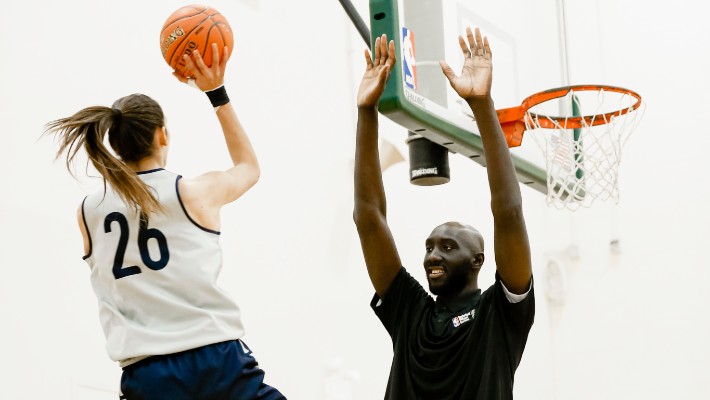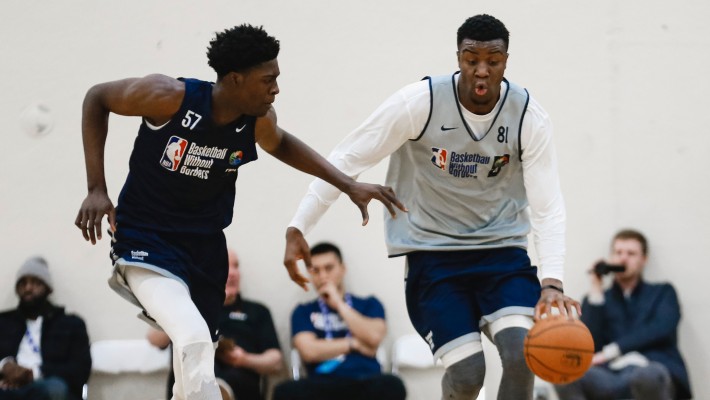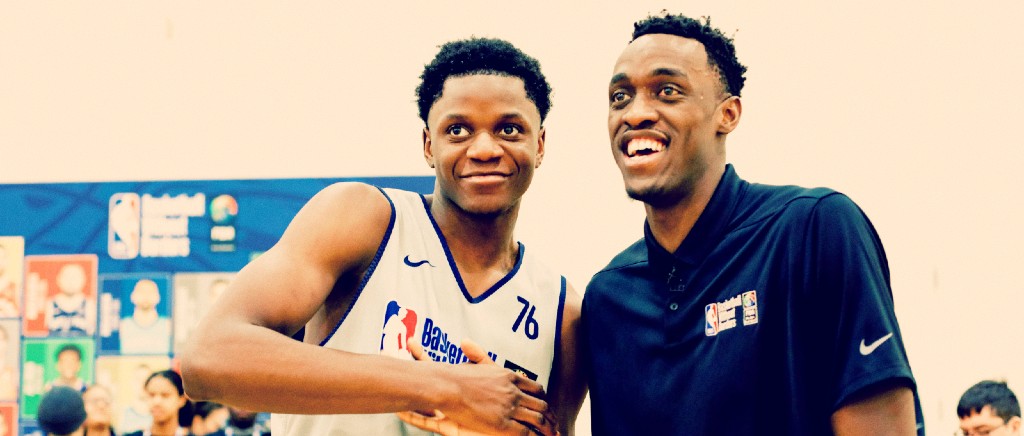CHICAGO — The stands at Quest Multisport, 15 minute west of Chicago, are mostly full on a Friday morning, as scouts and executives from around the NBA have made their way to the sixth annual Basketball Without Borders Global Camp at All-Star Weekend. Prominently placed on the wall next to a side court is a large poster with various alumni of the BWB program, an ever-growing list that includes All-Stars like Joel Embiid and Pascal Siakam.
The Global camp isn’t about discovery as much as it’s about opportunity. The NBA brings in 64 of the best young men’s and women’s players from around the world for the weekend to work on their games under the guidance of NBA coaching staffs and compete against top competition from six continents. The participants list includes potential future lottery picks, some players that will head off to play major college basketball, and highly-accomplished international players. No one there is an unknown commodity, but they’re afforded an opportunity to make a statement next to top prospects in their age range and make an impression on scouts from the NBA, Europe, and beyond who view the camp as a necessary stop during All-Star weekend.
Not only do team representatives flock to the camp, but players do as well, as alums of the program like Siakam and Lauri Markkanen, as well as international players like Davis Bertans, and Tacko Fall drop by to provide some coaching and advice for the young campers. As important as the opportunity is to be scouted and seen by teams from around the globe, it’s the involvement of the players that makes the camp so successful, as director of international basketball operations Chris Ebersole explained.
“I think what’s special about it is what you mention with players, because as staff and front offices, we can put together a pretty good structure, but without the players buying in, it’s not going to be as special as it can,” Ebersole told Dime. “To have those guys so invested in it — Pascal, Tacko was just with us in Senegal over the summer, Davis was with us in Latvia with us at BWB Europe, and only a few months later for them to come back and keep coming back. Just understanding how much impact and influence they have on these young players and the amount of education they can provide to these guys to make sure they’re preparing themselves the right way for the next level is, I think, really cool.”
That exposure to scouts, executives, coaches, and players is something that hasn’t always been afforded to players, especially from places that aren’t traditionally considered basketball hotbeds. It’s in those places that the BWB program is working to expand their reach, whether it’s through camps for players, clinics for coaches and referees, or building courts to improve the overall basketball ecosystem and infrastructure in those countries. For example, a BWB Europe camp took place in Latvia for the first time this past summer. Bertans viewed bringing this sort of thing — which he did not have as he was on a road that led to the NBA — to his home country as a point of pride.
“I think it’s an experience that is a chance for them to showcase themselves, which is the most important thing, having basically representatives from all the teams around the NBA and some European teams,” Bertans said. “When I was their age I didn’t really have a chance like that and I was never picked to any of these camps, and maybe I would’ve made it to the league earlier if I was. But I think for them they’re put in a great position and if they put the work in, they’re going to have a great future.”

Not unlike American players that return to their alma mater to offer advice and inspiration to youngsters on their college team, international players recognize the importance of giving back to the future generation at Basketball Without Borders camps and opening up those opportunities to players all over. Fall, who spoke glowingly of the experience of hosting a camp in Senegal, explained why it’s so important for him to work with BWB camps, even though he isn’t a graduate of the program himself.
“Absolutely, it is my responsibility [to give back],” Fall said. “Especially where I came from in my journey so far, and it’s a lot of people back home that are looking up to us. It’s our duty to pave the way for them and to guide them, and for me this is a way to do it.”
Siakam echoed that sentiment, noting his goal in coming back to camps is to show the campers that they’re on a path to success and provide them with some inspiration that they can get to the top levels of basketball.
“I think it’s awesome, just from someone that’s been there and done it and probably was a long time ago, but it’s always fun to be around,” Siakam said. “And I know what it feels like to be in their shoes. The global camp is a little different than the one I did, but it’s still the same concept and being able to play with players from different countries and stuff. Having the opportunity to be here is great. A lot of eyes watching and it’s incredible really. So when I come in I just make sure they see someone that’s been there and done it and that they can relate to, and someone they can look at his path and think they’re in a good situation and they’re doing something great.”
The campers themselves recognize the opportunity to ask questions of the NBA players and coaches at the camp, trying to take to heart the coveted nuggets of information they’re afforded that could help them take the next step in their games. Olivier-Maxence Prosper, a Canadian who now plays at the NBA Academy-Latin America and will play at Clemson next year, thinks it’s inspiring to see guys like Siakam and Fall back at the camps.
“Them coming here, being humble to give back to the younger kids,” Prosper said. “Like, they were one of us in the past years at this camp and look at them now. It’s all about them giving back, I met Tacko, I met Pascal, and just talking to them feels good. It tells me that if I continue to work, I can be there and I can do that. It’s all about them giving back, it inspires all of us.”
Ariel Hukporti, a 7-foot, 250-pound 17-year-old who plays for MHP Riesen Ludwigsburg in Germany, took home camp MVP honors and said seeing the NBA players that came back served as “big motivation,” noting he got a lot of pointers from the Bucks coaching staff on how to expand his offensive game.
Beyond the exposure to NBA players and staffs, almost everyone at the camp noted the biggest opportunity afforded to the attendees was the chance to play with kids from around the globe and learn about different cultures and play styles. Hukporti’s made note of the speed of the American game, and how much different the pace is from how his team plays in Germany.
“I like the style, because in Europe everyone is playing kinda slow, but they play fast here,” Hukporti told Dime. “They play fast. Like, the difference is between Europe basketball and, like American high school basketball is, like, high school basketball is way faster. This is way faster, they’re just grabbing the ball, getting the rebound, and pushing in transition. Like, in Germany or Europe we’re doing the same thing, but not that fast.”
Josh Giddey, who earned All-Camp honors out of Australia, also highlighted the differences in styles from the various regions represented.
“Yeah, the best players, 64 players, the best around the world, gathered in one place, it’s pretty cool,” Giddey said. “To get the different play styles from different countries is a big thing. Australians are different to the Europeans to the Americans and Africans, we all play differently, but to combine them and play as one thing is pretty cool. Americans and Africans are typically athletes, you know run and gun. Us and the Europeans are a little bit similar, more structured offense, but it’s a different environment and being able to change to it is a big thing.”

Embracing that diversity in play styles and cultures is something both Markkanen and Siakam noted was a crucial part of the camp and helped them in their development and their eventual adjustment to the NBA.
“Talk to other players. I was the only Finnish player when I was there and I kinda had a hard time with like, I was able to speak English, but it was my first time interacting with different nationalities,” Markkanen said when asked about the advice he wanted to give the players at the camp. “So I think just interacting with different players and trying to get them engaged with coaches and talk to other staff members, cause everybody talk to each other. There’s so many coaches, and I think that’s the biggest advice is just, on the court work on your game, but I think interacting and meeting new people.”
“I think for me it was just hanging out with different people from different countries,” Siakam said of the biggest impact the camp had on him. “I was always a reserved kid, so like, being in an environment like that was so great, cause I saw people that I don’t think I’d ever seen before, and it was so cool to hang out and just see people from countries that I know about but didn’t really know about. And you get to learn different things, and it was awesome.”
That experience is hard to replicate and might be where the Basketball Without Borders program and it’s recent cousin in the NBA Academies present the most unique opportunity. Not only is there the chance to work with world class coaches and players, but for so many of these kids it’s their first taste of meeting kids from all over and learning about different cultures on and off the court.
It’s there that Ebersole notes the program wants to continue expanding, offering opportunities to players from more countries and creating new ways for them to get the exposure and training that could get them to the professional ranks, either in the NBA or internationally. Part of that is the growth of their NBA Academy program, which currently has six academies in Mexico, Australia, China, Senegal, and India. Giddey, who plays at the NBA Academy in Australia, highlighted how it created such a unique opportunity for him to get exposure that wasn’t an option for him before.
“The academy is a pretty unique thing,” Giddey said. “It’s the best guys from all around the world in one gym, so I get to play against them every day. Before that, I really didn’t have any exposure, so coming over to the States to play, we were just in Barcelona for a tournament, and it’s a pretty cool thing.”
The expansion of women’s side of both the academies and BWB is a “point of focus” of the program’s growth going forward for Ebersole, who noted this summer they’ll have their second Next Generation Saturday women’s minicamp at the Final Four event for their academies this summer and 12 of the 24 girls at the BWB Global Camp came from their academies. To further their reach and impact, the league announced the creation of NBA Global Scout at the annual Tech Summit, an app that anyone, anywhere can download and upload their measurements and videos of them doing drills to an international database that can help them find prospects anywhere — for fans of American recruiting, something of a giant, international Hudl system.
The NBA has long sought to grow it’s global footprint, a vision from the late David Stern, and the acceleration of that comes from the success of international players in the NBA — and their desire to give back. It’s those players that offer the inspiration that a kid can come from anywhere and find success, and also can serve as the impetus for the league to expand operations in places they haven’t gone before.







